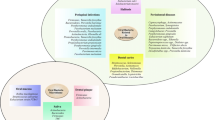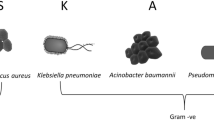Abstract
Purpose
Bacteria are known to have a high ability to manufacture many compounds with biological functions in a short time compared with eukaryotic cells due to the fact that bacterial cells possess efficient metabolic mechanisms for the manufacture of these compounds (intracellular or extracellular). Herein, the goal of this study is to use pathogenic Enterococcus aerogenes bacteria strains, namely, S1, S2, and S3, isolated from the mouths of individuals with dental decay to produce silver nanoparticles in an environmentally friendly and cost-effective manner.
Methods
These nanoparticles have been tested for antibacterial activity against Streptococcus mitis, an MDR bacterium, either alone or in combination with antibiotics. These bacteria were identified using morphological characteristics and biochemical tests, in addition to molecular methods such as PCR and DNA sequences. Besides, their identification was done on the basis of their alignment with the reference strains in the NCBI blast to calculate the degree of similarity among these strains (S1, S2, and S3).
Results
The results of the current study showed a clear synergistic effect in the inhibition of Streptococcus mitis bacteria when mixing silver nanoparticles with some antibiotics, and it was found that there is a synergistic effect when mixing those AgNPs with erythromycin, followed by streptomycin and tetracycline. In contrast, the effect was antagonistic in the case of streptomycin and tetracycline antibiotics.
Conclusion
Enterobacter aerogenes AgNPs demonstrated excellent antibacterial efficacy on Streptococcus mitis isolates. Therefore, AgNPs in the dental care area have a wide range of applications.
Lay Summary
The current study attempted to show how AgNPs have a broad range of uses in the dental care field. Therefore, the study employed AgNPs that were created by Enterobacter aerogenes bacterial strains (S1, S2, and S3) for dental caries patients. AgNPs from Enterobacter aerogenes exhibited strong antibacterial activity against Streptococcus mitis isolates.












Similar content being viewed by others
References
Clatworthy AE, Pierson E, Hung DT. Targeting virulence: a new paradigm for antimicrobial therapy. Nat Chem Biol. 2007;3(9):541–8.
Manna P, Jain SK. Obesity, oxidative stress, adipose tissue dysfunction, and the associated health risks: causes and therapeutic strategies. Metabol Synd Related Dis. 2015;13(10):423–44.
Deshmukh SP, Patil SM, Mullani SB, Delekar SD. Silver nanoparticles as an effective disinfectant: a review. Mater Sci Eng: C. 2019;97:954–65.
Parthasarathi V, Thilagavathi G. Synthesis and characterization of zinc oxide nanopartilce and its application on fabrics for microbe resistant defence clothing. Int J Pharm Pharmaceu Sci. 2011;3(4):392–8.
Abdeen S, Geo S, Praseetha PK, Dhanya RP. Biosynthesis of silver nanoparticles from Actinomycetes for therapeutic applications. International Journal of Nano Dimension. 2014;5(2):155–62.
Morones JR, Frey W. Room temperature synthesis of an optically and thermally responsive hybrid PNIPAM–gold nanoparticle. J Nanopart Res. 2010;12(4):1401–14.
Sabella FM, de Feiria SNB, Ribeiro ADA, Theodoro LH, Höfling JF, Parisotto TM, Duque C. Exploring the interplay between oral diseases, microbiome, and chronic diseases driven by metabolic dysfunction in childhood. Front Dental Med. 2021;2:718441.
Shay K. Infectious complications of dental and periodontal diseases in the elderly population. Clin Infect Dis. 2002;34(9):1215–23.
Shanmuganathan R, MubarakAli D, Prabakar D, Muthukumar H, Thajuddin N, Kumar SS, Pugazhendhi A. An enhancement of antimicrobial efficacy of biogenic and ceftriaxone-conjugated silver nanoparticles: green approach. Environ Sci Poll Res. 2018;25(11):10362–70.
Castro L, Blázquez ML, Muñoz JA, González F, Ballester A. Biological synthesis of metallic nanoparticles using algae. IET Nanobiotechnol. 2013;7(3):109–16.
Fayaz AM, Balaji K, Girilal M, Yadav R, Kalaichelvan PT, Venketesan R. Biogenic synthesis of silver nanoparticles and their synergistic effect with antibiotics: a study against gram-positive and gram-negative bacteria. Nanomed: Nanotechnol, Biol Med. 2010;6(1):103–9.
Hajishengallis G. Periodontitis: from microbial immune subversion to systemic inflammation. Nat Rev Immunol. 2015;15(1):30–44.
Kalimuthu K, Babu RS, Venkataraman D, Bilal M, Gurunathan S. Biosynthesis of silver nanocrystals by Bacillus licheniformis. Colloids Surf B: Biointerf. 2008;65(1):150–3.
Loesche W. Dental caries and periodontitis: contrasting two infections that have medical implications. Infect Dis Clin North Am. 2007;21(2):471–502.
Luo K, Jung S, Park KH, Kim YR. Microbial biosynthesis of silver nanoparticles in different culture media. J Agricult Food Chem. 2018;66(4):957–62.
Naheed A, Seema S, Singh V. Biosynthesis of silver nanoparticles from desmodium triflorum: a novel approach towards weed utilization. Biotechnol Res Int. 2011;8(1):1.
Roy A, Khanra K, Mishra A, d Bhttacharyya N. Highly cytotoxic (PA-1), less cytotoxic (A549) and antimicrobial activity of a green synthesized silver nanoparticle using Mikania cordata L. International. J Adv Res. 2013;1(5):193–8.
Saifuddin N, Wong CW, Yasumira AA. Rapid biosynthesis of silver nanoparticles using culture supernatant of bacteria with microwave irradiation. E-J Chem. 2009;6(1):61–70.
Singh H, Du J, Singh P, Yi TH. Extracellular synthesis of silver nanoparticles by Pseudomonas sp. THG-LS1. 4 and their antimicrobial application. J Pharma Anal. 2018;8(4):258–64.
Smekalova M, Aragon V, Panacek A, Prucek R, Zboril R, Kvitek L. Enhanced antibacterial effect of antibiotics in combination with silver nanoparticles against animal pathogens. Vet J. 2016;209:174–9.
Vanaja M, Paulkumar K, Baburaja M, Rajeshkumar S, Gnanajobitha G, Malarkodi C, et al. Degradation of methylene blue using biologically synthesized silver nanoparticles. Bioinorg Chem Appl. 2014;2014. https://doi.org/10.1155/2014/742346.
Yin IX, Zhang J, Zhao IS, Mei ML, Li Q, Chu CH. The antibacterial mechanism of silver nanoparticles and its application in dentistry. Int J Nanomedicine. 2020;15:2555–62. https://doi.org/10.2147/IJN.S246764.
Author information
Authors and Affiliations
Corresponding author
Ethics declarations
Conflict of Interest
The authors declare no competing interests.
Additional information
Publisher’s Note
Springer Nature remains neutral with regard to jurisdictional claims in published maps and institutional affiliations.
Rights and permissions
Springer Nature or its licensor (e.g. a society or other partner) holds exclusive rights to this article under a publishing agreement with the author(s) or other rightsholder(s); author self-archiving of the accepted manuscript version of this article is solely governed by the terms of such publishing agreement and applicable law.
About this article
Cite this article
Abd Ali, M.A., Shareef, A.A. Antibacterial Activity of Silver Nanoparticles Derived from Extracellular Extract of Enterococcus aerogenes Against Dental Disease Bacteria Isolated. Regen. Eng. Transl. Med. 10, 68–77 (2024). https://doi.org/10.1007/s40883-023-00304-2
Received:
Revised:
Accepted:
Published:
Issue Date:
DOI: https://doi.org/10.1007/s40883-023-00304-2




